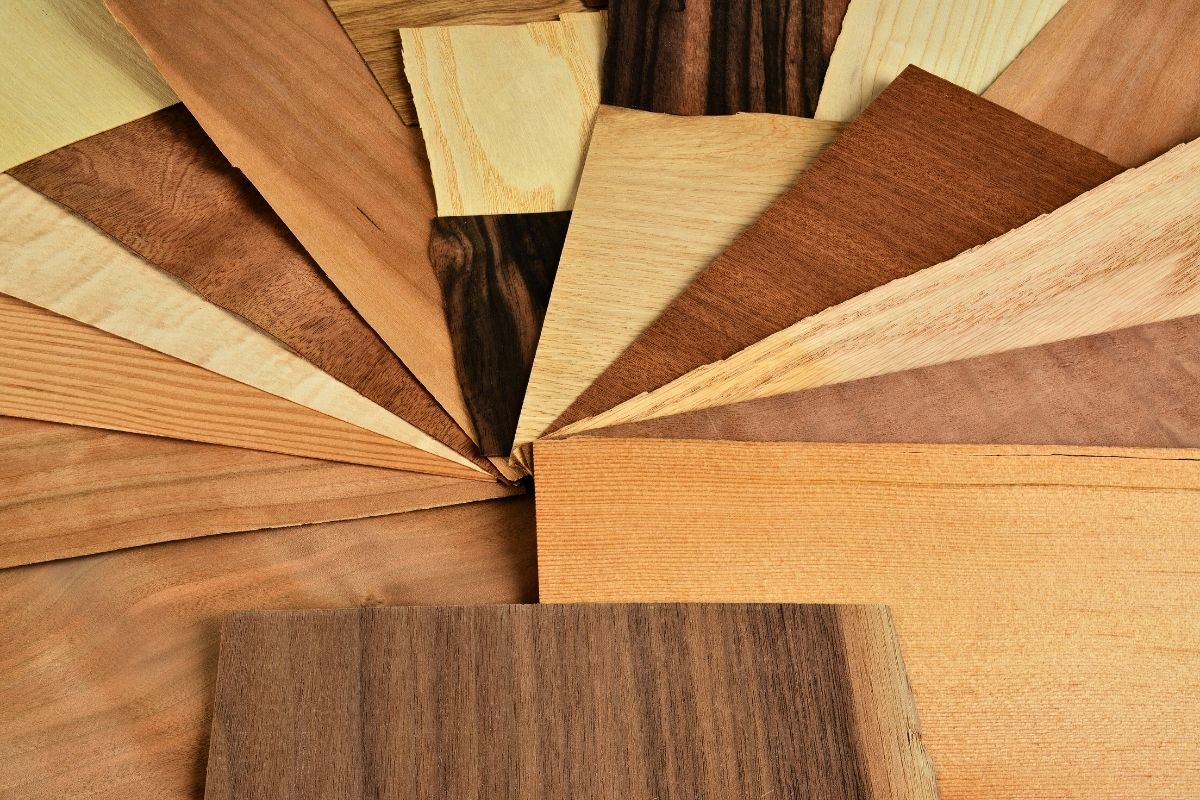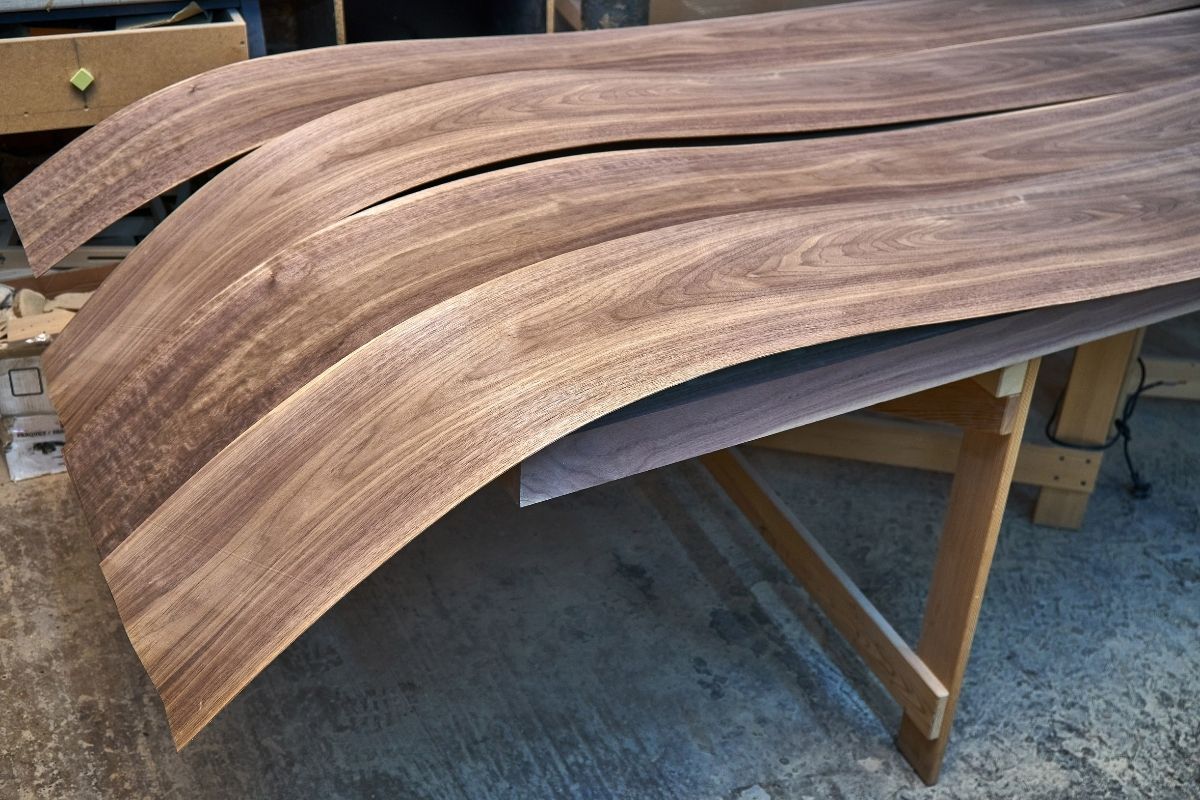What is Veneer and How is it Made?

When exploring different wood products for furniture or interior finishes, you may come across veneer. Many people wonder what is wood veneer and how it compares to solid wood or laminate. Veneer is widely used in woodworking, interior design, and architectural projects because it offers the beauty of real wood in a more resource-efficient, environmentally friendly way. This blog explains what veneer is, how it is made, and why it plays such an important role in modern design.
What is Wood Veneer?
Wood veneer refers to thin slices of natural wood that are bonded to a substrate such as medium-density fiberboard (MDF), particle board, or plywood. Veneer is made from real wood, carefully sliced from a solid piece of timber. Because it is genuine natural wood, veneer showcases authentic wood grain, growth rings, colour and pattern variations that occur within the same wood species.
A veneer sheet maintains the appearance of solid wood, but it uses much less raw material. This means veneer is an environmentally responsible option, allowing fine wood and exotic woods to be used more efficiently.
Veneer vs Solid Wood and Laminate
Solid wood furniture is made from whole pieces of timber. While beautiful, solid wood can be prone to warping and splitting when exposed to changes in humidity and temperature. Veneer, on the other hand, is applied to stable core panels that reduce movement, helping maintain durability and longevity.
Veneer is sourced from natural timber, while laminate or melamine surfaces are engineered materials that imitate the look of wood using printed patterns. Veneer provides the warmth and character of real wood, so veneer furniture looks more authentic than laminate, without requiring a full piece of timber.
How Veneer is Made: From Timber to Thin Layers
The process of making veneer begins with selecting a wood piece suitable for slicing. Logs are chosen for their grain pattern and overall quality.
1. Preparing the Timber
The log is cleaned and sometimes soaked or steamed to soften it. This makes the wood easier to slice or saw and helps ensure smooth, continuous thin slices.
2. Cutting the Veneer
There are several ways veneer is cut. The method influences the final grain pattern.
Common cuts include:
- Crown cut: Highlights curved grain patterns.
- Rift cut: Produces a straight and consistent grain.
- Cut and quarter: Often used to emphasise vertical grain lines.
Because veneer consists of very thin slices of wood, it can be cut with precision, which helps minimise waste such as saw kerf.
3. Drying and Grading
The thin veneer layer is dried to prevent warping, then sorted by quality. Variations naturally occur because each piece of wood is unique.
4. Backing and Bonding
Once the veneer sheets are sliced and dried, they are often attached to a backing material to make them stronger and easier to work with. The type of backing depends on where the veneer will be used:
- Paper backed: A thin paper layer adds flexibility, making the veneer easier to wrap around curved surfaces.
- Phenolic backed: A resin-impregnated backing provides extra durability and moisture resistance.
- Wood on wood or 2-ply: Two layers of veneer are bonded together for additional strength and a more stable surface.
- Utility grade wood backer: A more economical option often used for less visible surfaces.
Backing helps prevent cracking or warping and allows veneer to be confidently applied to flat panels such as doors, cabinets, drawers, and furniture surfaces.
Types of Veneers Used in Woodworking
There are several types of veneers available, each offering different looks and performance benefits depending on the project.
Real Wood Veneer and Timber Veneer
Real wood veneer (also called timber veneer) is made directly from natural wood logs. It displays authentic wood grain and colour variations, giving surfaces the look of solid wood. Popular options like oak veneer, walnut, and jarrah are often chosen for furniture, cabinetry, and interior wall panels where a natural, warm appearance is desired.
Engineered or Reconstituted Veneer
Engineered veneer is made by layering and colouring different wood fibres to create a consistent tone and pattern. It is commonly used in commercial fit-outs and large projects where designers need surfaces to match across multiple panels.
Paper Backed and Phenolic Backed Veneers
These veneer sheets are more flexible. This prevents cracking, allowing the veneer to be applied smoothly over curved surfaces, detailed cabinetry, and feature walls.
Veneer on Plywood, MDF, or Particle Board
When a veneer is bonded to a core material such as plywood, MDF, or particle board, it creates a stable panel. This offers the appearance of real wood without the warping that can happen with a full solid wood panel, making it ideal for furniture, doors, shelving, and joinery.

What Veneer is Mainly Used For
Veneer is widely used for:
- Interior design applications such as wall panels and cabinetry
- Furniture, where veneer allows intricate shapes and larger surfaces
- Decorative inlay, parquet, and marquetry work
- High-end architectural projects where consistency, sustainability, and premium appearance matter
Because veneer allows natural resource conservation, architects and designers often choose it to highlight the beauty of fine wood without the environmental cost of using full solid wood without restraint.
Advantages of Using Veneer
- Sustainable use of timber
- Maintains the appearance of genuine natural wood
- Reduces risk of movement, unlike solid wood
- More cost-effective, especially when using exotic woods
- Can be sanded and refinished multiple times, depending on the thickness
- Supports creative woodworking and interior applications
Is Veneer Durable?
When properly bonded and sealed, high-quality wood veneer products are strong, stable, and long-lasting. The performance of veneer depends on the substrate, installation method, and final finishing. Modern veneer technology ensures that veneer is made to meet high durability standards.
Final Thoughts
Veneer offers the beauty of real wood with the efficiency and stability of engineered backing. It is a versatile and environmentally friendly solution for creating elegant, natural-looking surfaces in homes, commercial spaces, and custom interiors. Whether used in solid wood furniture alternatives, cabinetry, or feature panels, veneer provides the warmth and character of timber while making responsible use of our valuable natural resource.
If you would like guidance in choosing the right veneer for your project, the team at Worldwide Timber Traders is here to help.
Related articles

Blog title heading will go here

Blog title heading will go here


